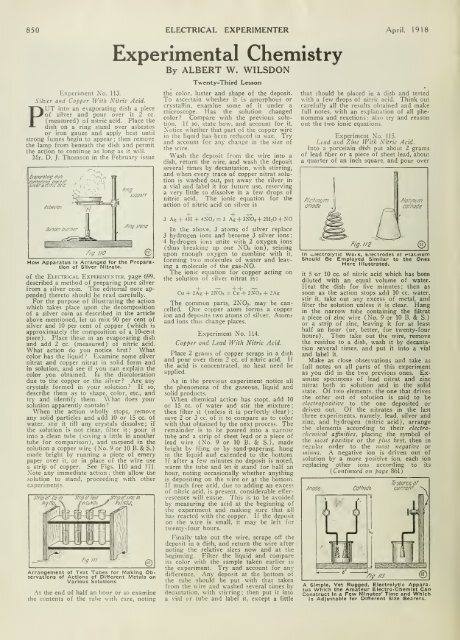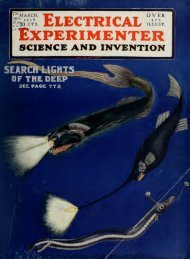The Electrical experimenter
The Electrical experimenter
The Electrical experimenter
You also want an ePaper? Increase the reach of your titles
YUMPU automatically turns print PDFs into web optimized ePapers that Google loves.
850 ELECTRICAL EXPERIMENTER April. 1918<br />
Experiment No. 113.<br />
Silver and Copper With Nitric Acid.<br />
PUT<br />
into an evaporating dish a piece<br />
of silver and pour over it 2 cc.<br />
(measured) of nitric acid. Place the<br />
dish on a ring stand over asbestos<br />
or iron gauze and apply heat until<br />
strong fumes begin to appear ; then remove<br />
the lamp from beneath the dish and permit<br />
the action to continue as long as it will.<br />
Mr. D. J. Thomson in the February issue<br />
Iroporottng dish<br />
;'<br />
' 'v\.-\<br />
containing, piece of .-— '" ''_><br />
Asbestos<br />
Experimental Chemistry<br />
By ALBERT W. WILSDON<br />
1 ng<br />
support<br />
Airy stood<br />
ftg //O e<br />
How Apparatus Is Arranged for the Preparation<br />
of Silver Nitrate.<br />
of the <strong>Electrical</strong> Experimenter, page 699.<br />
described a method of preparing pure silver<br />
from a silver coin. <strong>The</strong> editorial note appended<br />
thereto should be read carefully.<br />
For the purpose of illustrating the action<br />
which takes place upon the decomposition<br />
of a silver coin as described in the article<br />
above mentioned, let us mix 90 per cent of<br />
silver and 10 per cent of copper (which is<br />
approximately the composition of a 10-cent<br />
piece). Place these in an evaporating dish<br />
and add 2 cc (measured) of nitric acid.<br />
What action do you notice first? What<br />
color has the liquid? Examine some silver<br />
nitrat and copper nitrat in solid form and<br />
in solution, and see if you can explain the<br />
color you<br />
due to the<br />
obtained.<br />
copper or<br />
Is<br />
the<br />
the discoloration<br />
silver? Are any<br />
crystals formed in your solution? If so,<br />
describe<br />
try and<br />
them as<br />
identify<br />
to shape, color, etc., and<br />
them. What does your<br />
solution apparently contain?<br />
When the action wholly stops, remove<br />
any solid particles and add 10 or 15 cc. of<br />
water, stir it till any crystals dissolve; if<br />
the solution is not clear, filter it; pour it<br />
into a clean tube (saving a little in another<br />
tube for comparison), and suspend in the<br />
solution a copper wire (No. 9 or 10 B. & S.)<br />
made bright by running a piece of emery<br />
paper over it, or in place of the wire use<br />
a strip of copper. See Figs. 110 and 111<br />
Note any immediate action ; then allow the<br />
solution to stand, proceeding with other<br />
experiments.<br />
Strip of. Cu in<br />
AyMo, "<br />
Fig III ©<br />
Arrangement of Test Tubes for Making Observations<br />
of Actions of Different Metals on<br />
Various Solutions<br />
At the end of half an hour or so examine<br />
the contents of the tube with care, noting<br />
Twenty-Third Lesson<br />
the color, luster and shape of the deposit.<br />
To ascertain wr hether it is amorphous or<br />
crystallin, examine some of it under a<br />
microscope. Has the solution changed<br />
color? Compare with the previous solution.<br />
If so, state how, and account for it.<br />
Notice whether that part of the copper wire<br />
in the liquid has been reduced in size. Try<br />
and account for any change in the size of<br />
the wire.<br />
Wash the deposit from the wire into a<br />
dish, return the wire, and wash the deposit<br />
several times by decantation, with stirring,<br />
and when every trace of copper nitrat solution<br />
is washed out, put away the silver in<br />
a vial and label it for future use, reserving<br />
a very little to dissolve in a few drops of<br />
nitric acid. <strong>The</strong> ionic equation for the<br />
action of nitric acid on silver is<br />
+ _ + _<br />
3 Ag + 4H + 4NOs = 3 Ag+3NO„ + 2H 2 + NO<br />
In the above, 3 atoms of silver replace<br />
3 hydrogen ions and become 3 silver ions<br />
4 hydrogen ions unite with 2 oxygen ions<br />
(thus breaking up one NOa ion), seizing<br />
upon enough oxygen to combine with it,<br />
forming two molecules of water and leaving<br />
a molecule of the gas-NO.<br />
<strong>The</strong> ionic equation for copper acting on<br />
the solution of silver nitrat is:<br />
+ — ++ —<br />
Cu + 2Ag + 2NO, - Cu + 2N0 3 + 2Ag<br />
<strong>The</strong> common parts, 2N0 3 , may be cancelled.<br />
One copper atom forms a copper<br />
ion and deposits two atoms of silver. Atoms<br />
and ions thus change places.<br />
Experiment No. 114.<br />
Copper and Lead With Nitric Acid.<br />
Place 2 grams of copper scraps in a dish<br />
and pour over them 2 cc. of nitric acid. If<br />
the acid is concentrated, no heat need be<br />
applied.<br />
As in the previous experiment notice all<br />
the phenomena of the gaseous, liquid and<br />
solid products.<br />
When chemical action has stopt, add 10<br />
or IS cc. of water and stir the mixture<br />
then filter it (unless it is perfectly clear) ;<br />
save 2 or 3 cc. of it to compare as to color<br />
with that obtained by the next process. <strong>The</strong><br />
remainder is to be poured into a narrow<br />
tube and a strip of sheet lead or a piece of<br />
lead wire (No. 9 or 10 B. & S.), made<br />
bright by tiling or by sand-papering, hung<br />
in the liquid and extended to the bottom.<br />
If after a few minutes no deposit is noted,<br />
warm the tube and let it stand for half an<br />
hour, noting occasionally whether anything<br />
is depositing on the wire or at the bottom.<br />
If much free acid, due to adding an excess<br />
of nitric acid, is present, considerable effervescence<br />
will ensue. This is to be avoided<br />
by measuring the acid at the beginning of<br />
the experiment and making sure that all<br />
has reacted with the copper. If the deposit<br />
on the wire is small, it may be left for<br />
twenty-four hours.<br />
Finally take out the wire, scrape off the<br />
deposit in a dish, and return the wire after<br />
noting the relative sizes now and at the<br />
beginning. Filter the liquid and compare<br />
its color with the sample taken earlier in<br />
the experiment. Try and account for any<br />
difference. Any deposit at the bottom of<br />
the tube should be put with that taken<br />
from the wire and washed several times by<br />
decantation, with stirring; then put it into<br />
a vial or tube and label it. except a little<br />
; ;<br />
that should be placed in a dish and tested<br />
with a few drops of nitric acid. Think out<br />
carefully all the results obtained and make<br />
full notes, with an explanation of all phenomena<br />
and reactions ; also try and reason<br />
out the two ionic equations.<br />
Experiment No. 115.<br />
Lead and Zinc With Nitric Acid.<br />
Into a porcelain dish put about 2 grams<br />
of lead fiber or a piece of sheet lead, about<br />
a quarter of an inch square, and pour over<br />
P/cftfwm \<br />
anode X<br />
Fig. 1/2<br />
P/otinum<br />
©<br />
In electrolytic Woi K, tlectrodes or Platinum<br />
Should Be Employed Similar to the Ones<br />
Here Illustrated.<br />
it 5 or 10 cc of nitric acid which has been<br />
diluted with an equal volume of water.<br />
Heat the dish for five minutes ; then as<br />
soon as the action stops add 10 cc. water,<br />
stir it, take out any excess of metal, and<br />
filter the solution unless it is clear. Hang<br />
in the narrow tube containing the nitrat<br />
a piece of zinc wire (No. 9 or 10 B. & S.)<br />
or a strip of zinc, leaving it for at least<br />
half an hour (or, better, for twenty-four<br />
hours). <strong>The</strong>n take out the wire, remove<br />
the residue to a dish, wash it by decantation<br />
several times, and put it into a vial<br />
and label it.<br />
Make as close observations and take as<br />
full notes on all parts of this experiment<br />
as you did in the two previous ones. Examine<br />
specimens of lead nitrat and zinc<br />
nitrat both in solution and in the solid<br />
state. Of two elements, the one that drives<br />
the other out of solution is said to be<br />
electropositive to the one deposited or<br />
driven out. Of the nitrates in the last<br />
three experiments, namely, lead, silver and<br />
zinc, and hydrogen (nitric acid), arrange<br />
the elements according to their electrochemical<br />
affinities, placing the symbol of<br />
the most positive or the (•Ins first, then in<br />
regular order to the most negative or<br />
minus. A negative ion is driven out of<br />
solution by a more positive ion, each ion<br />
replacing other ions according to its<br />
(Continued on page 861)<br />
•' ~;se<br />
fig //J<br />
To source of<br />
current<br />
A Simple, Yet Rugged, Electrolytic Apparatus<br />
Which the Amateur Electro-Chemist Can<br />
Construct in a Few Minutes' Time and Which<br />
Is Adjustable for Different Size Bearers.




